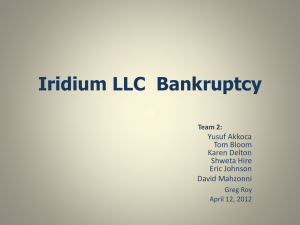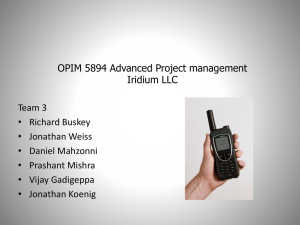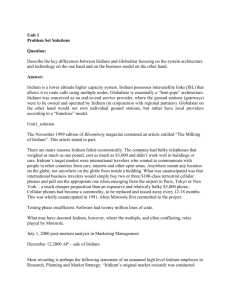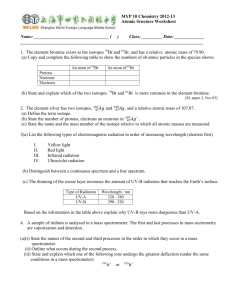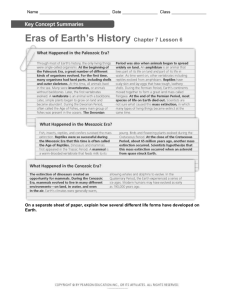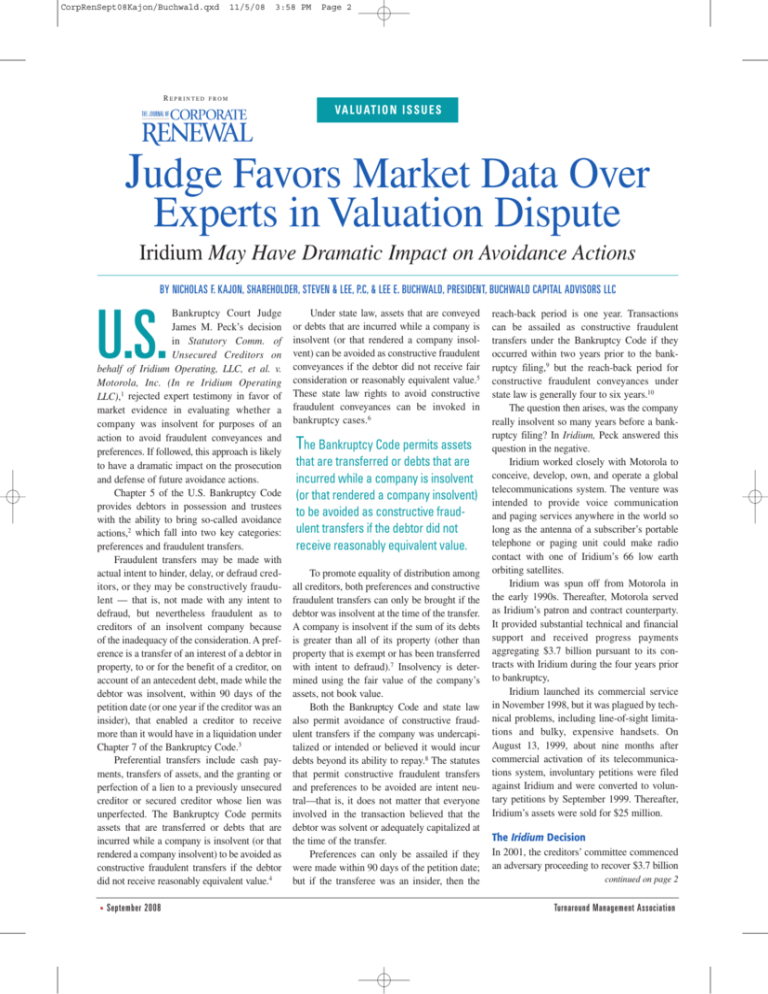
CorpRenSept08Kajon/Buchwald.qxd
REPRINTED
11/5/08
3:58 PM
Page 2
FROM
VA L U AT I O N I S S U E S
Judge Favors Market Data Over
Experts in Valuation Dispute
Iridium May Have Dramatic Impact on Avoidance Actions
BY NICHOLAS F. KAJON, SHAREHOLDER, STEVEN & LEE, P.C, & LEE E. BUCHWALD, PRESIDENT, BUCHWALD CAPITAL ADVISORS LLC
Bankruptcy Court Judge
James M. Peck’s decision
in Statutory Comm. of
Unsecured Creditors on
behalf of Iridium Operating, LLC, et al. v.
Motorola, Inc. (In re Iridium Operating
LLC),1 rejected expert testimony in favor of
market evidence in evaluating whether a
company was insolvent for purposes of an
action to avoid fraudulent conveyances and
preferences. If followed, this approach is likely
to have a dramatic impact on the prosecution
and defense of future avoidance actions.
Chapter 5 of the U.S. Bankruptcy Code
provides debtors in possession and trustees
with the ability to bring so-called avoidance
actions,2 which fall into two key categories:
preferences and fraudulent transfers.
Fraudulent transfers may be made with
actual intent to hinder, delay, or defraud creditors, or they may be constructively fraudulent — that is, not made with any intent to
defraud, but nevertheless fraudulent as to
creditors of an insolvent company because
of the inadequacy of the consideration. A preference is a transfer of an interest of a debtor in
property, to or for the benefit of a creditor, on
account of an antecedent debt, made while the
debtor was insolvent, within 90 days of the
petition date (or one year if the creditor was an
insider), that enabled a creditor to receive
more than it would have in a liquidation under
Chapter 7 of the Bankruptcy Code.3
Preferential transfers include cash payments, transfers of assets, and the granting or
perfection of a lien to a previously unsecured
creditor or secured creditor whose lien was
unperfected. The Bankruptcy Code permits
assets that are transferred or debts that are
incurred while a company is insolvent (or that
rendered a company insolvent) to be avoided as
constructive fraudulent transfers if the debtor
did not receive reasonably equivalent value.4
U.S.
•
September 2008
Under state law, assets that are conveyed
or debts that are incurred while a company is
insolvent (or that rendered a company insolvent) can be avoided as constructive fraudulent
conveyances if the debtor did not receive fair
consideration or reasonably equivalent value.5
These state law rights to avoid constructive
fraudulent conveyances can be invoked in
bankruptcy cases.6
The Bankruptcy Code permits assets
that are transferred or debts that are
incurred while a company is insolvent
(or that rendered a company insolvent)
to be avoided as constructive fraudulent transfers if the debtor did not
receive reasonably equivalent value.
To promote equality of distribution among
all creditors, both preferences and constructive
fraudulent transfers can only be brought if the
debtor was insolvent at the time of the transfer.
A company is insolvent if the sum of its debts
is greater than all of its property (other than
property that is exempt or has been transferred
with intent to defraud).7 Insolvency is determined using the fair value of the company’s
assets, not book value.
Both the Bankruptcy Code and state law
also permit avoidance of constructive fraudulent transfers if the company was undercapitalized or intended or believed it would incur
debts beyond its ability to repay.8 The statutes
that permit constructive fraudulent transfers
and preferences to be avoided are intent neutral—that is, it does not matter that everyone
involved in the transaction believed that the
debtor was solvent or adequately capitalized at
the time of the transfer.
Preferences can only be assailed if they
were made within 90 days of the petition date;
but if the transferee was an insider, then the
reach-back period is one year. Transactions
can be assailed as constructive fraudulent
transfers under the Bankruptcy Code if they
occurred within two years prior to the bankruptcy filing,9 but the reach-back period for
constructive fraudulent conveyances under
state law is generally four to six years.10
The question then arises, was the company
really insolvent so many years before a bankruptcy filing? In Iridium, Peck answered this
question in the negative.
Iridium worked closely with Motorola to
conceive, develop, own, and operate a global
telecommunications system. The venture was
intended to provide voice communication
and paging services anywhere in the world so
long as the antenna of a subscriber’s portable
telephone or paging unit could make radio
contact with one of Iridium’s 66 low earth
orbiting satellites.
Iridium was spun off from Motorola in
the early 1990s. Thereafter, Motorola served
as Iridium’s patron and contract counterparty.
It provided substantial technical and financial
support and received progress payments
aggregating $3.7 billion pursuant to its contracts with Iridium during the four years prior
to bankruptcy,
Iridium launched its commercial service
in November 1998, but it was plagued by technical problems, including line-of-sight limitations and bulky, expensive handsets. On
August 13, 1999, about nine months after
commercial activation of its telecommunications system, involuntary petitions were filed
against Iridium and were converted to voluntary petitions by September 1999. Thereafter,
Iridium’s assets were sold for $25 million.
The Iridium Decision
In 2001, the creditors’ committee commenced
an adversary proceeding to recover $3.7 billion
continued on page 2
Turnaround Management Association
CorpRenSept08Kajon/Buchwald.qxd
11/5/08
JUDGE FAVORS MARKET DATA
continued from page 1
from Motorola under various theories, including the avoidance of fraudulent conveyances
made within four years preceding the petition
date under applicable non-bankruptcy law.
Unlike the committee’s breach of fiduciary
duty, breach of contract, and equitable subordination counts, the fraudulent conveyance
and preference claims required the committee
to establish that Iridium was insolvent or
undercapitalized. After a five-day trial, Peck
dismissed the fraudulent conveyance and
preference counts because the committee
failed to do so.
The committee attempted to prove insolvency through expert testimony. The committee’s expert considered all of the standard
valuation methodologies — the cost approach,
precedent transactions, market comparables
(or guideline companies), and the discounted
cash flow (DCF) methodology — but concluded that only the DCF methodology should
be used to value Iridium.
Motorola also used a DCF approach, but
importantly, also established the following
contemporaneous reference points of
Iridium’s value, which were ignored by the
committee’s expert in his solvency analysis:
stock price, market capitalization, analyst
reports, investment banker valuations, comparable company analyses, and the fact that
Iridium’s auditors (KPMG) had not issued
going concern qualifications11 for the company.
Specifically, Motorola introduced evidence that Iridium knew that its system had
line-of-sight limitations and such technological limitations were publicly disclosed to
investors. Iridium spent considerable effort
developing and refining its business plan and
projections. On December 19, 1997, Iridium
entered into an agreement with a syndicate
of banks for a $1 billion credit facility,
which was 1.7 times oversubscribed and
was increased from the originally proposed
amount of $750 million. Additional credit was
extended in December 1998 after substantial
due diligence concerning Iridium’s overall
capital structure and financing plan.
During the mid to late 1990s, when the
company was purportedly insolvent, Iridium
and its affiliates were also able to raise substantial capital in the public debt and equity
markets, after significant due diligence by
investors and underwriters. Throughout 1997
Dedicated To Corporate Renewal
3:58 PM
Page 3
and 1998, Iridium’s stock prices ranged from
$17 to more than $70, implying an equity valuation between $2.3 billion and $10 billion.
Significantly, “Iridium’s implied market value
based on price per share was lower than the
discounted cash flow…values reached by
investment bankers at the time. This correlation between the DCF analysis and the value
implied by the public markets is an indication
that irrational exuberance did not distort
Iridium’s stock price.” 12
From January 1998 to January 1999,
analysts believed that Iridium’s equity value
ranged between $4 billion and $14 billion.
Iridium had a conservative debt-to-equity ratio
and was able to pay its debts as they came due
until shortly before its demise. Finally,
Motorola introduced evidence that as of
December 31, 1996, 1997, and 1998, KPMG
had concluded that Iridium was a going concern, and as late as March 1999, KPMG reexamined the company and concluded that no
substantial doubt existed about its ability to
continue as a going concern.
Basically, before calling its experts,
Motorola marshaled substantial contemporaneous market evidence supporting its position
that Iridium was solvent at the time of the
transfers.13 Motorola’s experts relied on this
substantial record and their own DCF analysis
in concluding that Iridium was solvent.14
Peck started his analysis by observing that:
“Courts generally look at a combination of valuation methodologies to determine valuation,
including: (a) actual sale price, (b) discounted
cash flow method, commonly referred to as
DCF, (c) adjusted balance sheet method, (d)
market multiple approach, (e) comparable
transactions analysis, and (f) market capitalization.”15 In determining capital adequacy, courts
look to “such factors as the company’s debt to
equity ratio, its historical capital cushion, and
the need for working capital in the specific
industry at issue,” but the focus is on the reasonableness of projections at the time they
were made, not on what ultimately happened to
the company.16
In analyzing the value of Iridium’s business, Peck placed heavy emphasis on market
evidence that reflected positive enterprise
value, including the stock price, assessments of
market analysts, and the company’s ability to
raise debt and equity capital during the time it
was supposedly insolvent. Peck declined to
take into consideration the fact that Iridium
failed so spectacularly after the transfers had
been made because that would constitute
“improper hindsight analysis in valuing a company’s pre-bankruptcy assets.”17
Instead, the Iridium decision followed the
3d U.S. Circuit Court of Appeals’ decision in
VFB LLC v. Campbell Soup Co.,18 in which the
court relied on the post-spin market price of
Vlasic’s stock to determine that the spin-off
was not a fraudulent conveyance. The Iridium
decision quoted Campbell approvingly: “Absent
some reason to distrust it, the market price is ‘a
more reliable measure of the stock’s value
than the subjective estimates of one or two
expert witnesses.’”19
Peck also cited Supreme Court precedent
on the importance of the markets in determining value:
“With the presence of a market, the market
is interposed between seller and buyer
and, ideally, transmits information to the
investor in the processed form of a market
price. Thus the market is performing a substantial part of the valuation process performed by the investor in a face-to-face
transaction. The market is acting as the
unpaid agent of the investor, informing him
that given all the information available to it,
the value of the stock is worth the market
price.”20
Importantly, in Campbell, the 3d Circuit
also pointed out that if the market capitalization had been inflated by the company’s
manipulations of the financial statements, then
it would not have been good evidence of value.
This does not appear to have been an issue in
Iridium, where sophisticated market participants were simply spectacularly wrong about
the company’s prospects.
Peck also gave significant weight to contemporaneous projections of Iridium’s management, because they were “reasonable and
prudent when made.”21 Next, the judge relied
on the contemporaneous analysis of value
performed by investment bankers, underwriters of Iridium’s debt and equity, and lenders,
all of which supported the view that the company was solvent. Basically, private parties
“putting their money where their mouths are”
is more reliable than expert reports done for
purposes of litigation, which can be “too subjective and too subject to manipulation.”22
Finally, Peck turned to the committee’s
DCF analysis. First, in performing his gatekeeper function mandated by the Supreme
Court in Daubert,23 Peck noted that expert
evidence could only be admitted if it is both
reliable and relevant, and that Daubert also
applies to weight and credibility determinations.24 The Iridium court found that plaintiff’s
DCF analysis was not credible because the
continued on page 3
September 2008
•
2
CorpRenSept08Kajon/Buchwald.qxd
11/5/08
3:58 PM
JUDGE FAVORS MARKET DATA
continued from page 2
committee’s experts failed to adequately
explain, rebut, or analyze the conflicting market evidence.25
The Iridium court found that contemporaneous market data is more reliable than
expert testimony, which can be tainted by
improper “hindsight bias” and may reflect an
advocate’s point of view. This was consistent
with Peck’s observation at the outset of his
opinion: “Any reader of The Wall Street
Journal knows that the markets are risky and
unpredictable and that share prices frequently
are influenced by a variety of factors unrelated to the fundamentals and potential of a particular company. Nonetheless, the public trading market constitutes an impartial gauge of
investor confidence and remains the best and
most unbiased measure of fair market value
and, when available to the Court, is the preferred standard of valuation.”26
Future Disputes
In light of Iridium and Campbell, courts in
the two most common venues for Chapter 11
cases — the Southern District of New York
and Delaware (which is in the 3d Circuit) —
have adopted a rule favoring market evidence
over expert testimony in evaluating whether a
debtor was insolvent for purposes of avoidance actions. If followed, the Iridium decision
will make it far more difficult to establish
insolvency in the years preceding bankruptcy
when there is market evidence to support
positive valuations.
Thus, where stock prices reflected positive value, bonds traded at or above par, or a
company was able to raise additional capital,
transfers should be insulated from subsequent
avoidance action attack, unless the financials
can be shown to have overstated the company’s true condition. This will protect defendants from improper 20/20 hindsight and
results-driven valuations.
Importantly, even under the approach
adopted by Iridium and Campbell, market
evidence can be rebutted if a plaintiff can
demonstrate that the market failed to take into
account relevant information. The most obvious example of this would be a situation in
which a company engaged in financial fraud,
but the same result should apply if the financial statements on which market participants
relied are otherwise flawed.
3 • September 2008
Page 4
Likewise, market evidence of solvency
might be overcome if the market was too
thinly traded to be a reliable indicator of value,
if market manipulation can be established, or if
other exogenous events distorted the market
price. “Irrational exuberance” comes to mind,
although Peck specifically found that was not
the case in Iridium.
Credit default swaps may also have an
impact on prices of debt instruments.
Situations in which stock traded for only a
nominal amount could presumably be explained as reflecting “option” or control value,
rather than being evidence of solvency. Finally,
defensive loans from existing lenders trying to
protect their positions should not be viewed in
the same light as fresh capital from new investors
who performed substantial due diligence.
As market valuation becomes more common in bankruptcy cases, situations may arise
when market indicators conflict. For example,
how would a court evaluate a company that has
stock trading at a non-nominal value and debt
trading at a significant discount from par? The
price of debt is usually considered a fair market
assessment of the likelihood that the debt will
either be repaid or that the issuer might default.
A bond price could be signaling a significant
risk of default while the stock is still trading at
meaningful levels.
The parties to a valuation dispute obviously
will advocate the valuation based on the securities that best suit their point of view.
Ironically, a situation like this may mean that
the courts will have to return to the traditional
valuation methodologies to resolve future
valuation disputes. CR
1
2
3
4
5
6
7
8
9
10
373 B.R. 283 (Bankr. S.D.N.Y. 2007).
Creditors’ committees and other creditor representatives (such as trustees under liquidating
trusts) are also sometimes empowered to bring
avoidance actions and other claims that belong to
the debtor’s estate.
11 U.S.C. Section 547(b).
11 U.S.C. Section 548(a)(1)(B).
See, e.g., New York Debtor and Creditor Law
Section 273.
11 U.S.C. Section 544.
11 U.S.C. Section 101(32).
11 U.S.C. Section 548(a)(1)(B)(ii)(II)-(III); New
York Debtor and Creditor Law Section 274-75.
11 U.S.C. Section 548(a)(1)(two-year reach-back
for cases filed on or after April 17, 2006).
Transactions that occurred six years before a
bankruptcy filing can be challenged if New York
law governs. 11 U.S.C. Section 544 & 108(a);
New York Debtor and Creditor Law Section 273,
et seq.; New York Civil Practice Law and Rules
Section 213(8). The reach-back period under the
Uniform Fraudulent Transfer Act, which has been
11
12
13
14
15
16
17
18
19
20
21
22
23
24
25
26
adopted in most states and which was applicable
in Iridium, is four years.
373 B.R. at 339.
Id. at 334.
Id. at 311-37.
Id. at 337-39.
Id. at 344 (citations omitted).
Id. at 345.
Id.
482 F.3d 624 (3rd Cir. 2007).
373 B.R. at 347, citing Campbell, 482 F.3d at 633.
Id. at 347, quoting Basic Inc. v. Levinson, 485
U.S. 224, 244 (1988).
Id. at 347 (citations omitted).
Id. at 348 (citations omitted).
Daubert v. Merrell Dow Pharmaceuticals, 509
U.S. 579 (1993) (holding that expert evidence
should be admissible only after it has been established that the evidence is reliable and scientifically valid, that trial judges have the duty to act as
gatekeepers charged with preventing junk science
from entering the courtroom, and discussing four
factors: testing, peer review, error rates, and
acceptability in the relevant scientific community).
373 B.R. at 349 (citations omitted).
Id. at 350-51.
Id. at 293.
Nicholas F. Kajon (top photo)
is a shareholder of Stevens &
Lee, P.C., and a member of
the Bankruptcy and Corporate Restructuring Group practicing in the New York office,
and Lee E. Buchwald (bottom
photo) is the founder and
president of Buchwald
Capital Advisors LLC, a New
York City investment banking
firm specializing in financial
reorganizations. Prior to
founding his firm, Buchwald
was an executive at
Rothschild Inc., Salomon Brothers, and Chanin
Capital Partners. Kajon can be reached at
nfk@stevenslee.com or (212) 537-0403, and
Buchwald can be reached at (212) 551-1040 or
lbuchwald@buchwaldcapital.com.
This article is intended as a general guide only
and does not constitute legal advice of Stevens &
Lee, P.C., or any member of the firm with respect
to the legal issues described. The opinions
expressed are those of the authors and not necessarily those of their respective firms. It is recommended that readers seek professional advice and
not rely on this general guide in structuring transactions in which they are involved.
This article is reprinted with permission of The
Journal of Corporate Renewal. All rights reserved.
Turnaround Management Association


